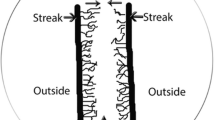Abstract
Cryptococcus neoformans and Candida albicans produced a pink pigment from media containing tryptophan. Approximately 30% of the C. neoformans strains produced large amounts of the pink (purple after 6 days) pigment in the absence of light whereas 70% of the Cryptococcus neoformans strains, as well as C. laurentii, C. albidus, C. diffluens, and C. albicans also produced the pink pigment with light being required for significant early production (2–6 days). Significant production did occur for Cryptococcus but not Candida species in the dark after extended incubation (10–25 days). C. terreus produced brown pigments from tryptophan and C. luteolus produced a trace of a buff pigment. Most Candida species produced either pink or brown pigments but not both. In contrast, many Cryptococcus species producing the pink pigment simultaneously produced brown pigments. C. terreus, C. albidus, and C. diffluens produced brown pigments from anthranilic acid whereas C. neoformans, C. laurentii, C. luteolus, and the medically important Candida species did not produce significant amounts of pigments from anthranilic acid. Cryptococcus and Candida species were autofluorescent when tryptophan was a major nitrogen source whereas yeast cell autofluorescence was not observed when anthranilic acid was used. Pigmentation of some Cryptococcus species also the substrate.
Similar content being viewed by others
References
Benjamin, A. M., and D. V. Tamhane. 1966. Observations on the formation of a pigment by strains of Escherichia coli. Arch. Mikrobiol. 53: 242–247.
Chaskes, S., and A. W. Phillips. 1974. Pigmentation and autofluorescence of Candida species after growth and tryptophan media. Can. J. Microbiol. 20: 595–603.
Chaskes, S., and R. L. Tyndall. 1975. Pigment production by Cryptococcus neoformans from para and ortho-diphenols: Effect of nitrogen source. J. Clin. Microbiol. 1: 509–514.
Chaskes, S., and R. L. Tyndall. 1978. Pigment production by Cryptococcus neoformans and other Cryptococcus species from aminophenols and diaminobenzenes. J. Clin. Microbiol. 7: 146–152.
Hopper, R. L., and D. Gröschel. 1975. Six-hour pigmentation test for the identification of Cryptococcus neoformans. J. Clin. Microbiol. 2: 96–98.
Hooper, R. L., and F. Blank. 1975. Caffeic acid-containing medium for the identification of Cryptococcus neoformans. J. Clin. Microbiol. 2: 115–120.
Kapica, L., and C. E. Shaw. 1969. Improvement in laboratory diagnosis of pulmonary cryptococcosis. Cand. Med. Assoc. J. 101: 582–585.
Kaplan, W., and M. S. Ivens. 1960. Fluorescent antibody staining of Sporotrichum schenckii in cultures and clinical materials. J. Invest. Dermatol. 35: 151–159.
Kaplan, W., and L. Kaufman. 1961. The application of fluorescent antibody techniques to medical mycology — A review. Sabouraudia 1: 137–144.
Korth, H., and G. Pulverer. 1971. Pigment formation for differentiating Cryptococcus neoformans from Candida albicans. Appl. Microbiol. 21: 541–542.
Krishnamurthi, V. S., P. J. Buckley, and J. A. Duerre. 1969. Pigment formation from L-tryptophan by a particular fraction from atypical Proteus rettgeri (corrected tittle). Arch. Biochem. Biochem. Biophys. 130: 636–645.
Miura, T., and T. Kasai. 1964. Autofluorescence of pathogenic fungi. Tohoku J. Exp. Med. 82: 158–163.
Miura, T., and T. Kasai. 1964. Difference in result of the fluorescent antibody staining of dermatophytes due to the difference of fixing procedure. Tohoku J. Exp. Med. 84: 72–80.
Pulverer, G., and H. Korth. 1971. Cryptococcus neoformans: Pigment-bildung aus verschiedenen polyphenolen. Med. Microbiol. Immunol. 157: 46–51.
Polster, M., and M. Svobodova. 1964. Production of reddishbrown pigment from dl-tryptophan by enterobacteria of the Proteus-Providencia group. Experientia (Basel), 20: 637–638.
Prévot, A. R., and M. Raynaud. 1944. Premières recherches sur la coralline pigment de Clostridium corallinum P. et R. Inst. Pasteur (Paris) 70: 185–186.
de Robichun-Szulmajster, H., and Y. Surdin-Kerjan. 1971. Nucleic acid and protein synthesis in yeasts: Regulation of synthesis and activity p. 336–418. In A. H. Rose and J. S. Harrison (eds) The Yeasts. Academic Press, London and New York.
Schindler, F., and H. Zähner. 1971. Stoffwechsel-produkte von Mikroorganismen: 91. Tryptanthrin, ein von Tryptophan abzuleitendes Antibioticum aus Candida lipolytica. Arch Mikrobiol. 79: 187–203.
Shaw, C. E., and L. Kapica. 1972. Production of diagnostic pigment by phenoloxidase activity of Cryptococcus neoformans. Appl. Microbiol. 24: 824–830.
Shields, A. B., and L. Ajello. 1966. Medium for selective isolation of Cryptococcus neoformans. Science (Washington, D.C.) 151: 208–209.
Staib, F. 1962. Vogelkot, ein Nährsubstrat für die Gattung Cryptococcus. Zentralbl. Bakteriol. Parasitenkd. Infektionskr. Hyg. Abt. 1. M. H. Orig. 186: 233–247.
Staib, F. 1962. Cryptococcus neoformans and Guizotia abyssinica (syn. G. oleifera D. C.). Z. Hyg. Infektionskr. 148: 466–475.
Staib, F., H. S. Randhawa, G. Grosse, and A. Blisse. 1973. Cryptococcose. Zur Identifizierung von Cryptococcus neoformans aus klinischem Untersuchungsmaterial. Zentralbl. Bakteriol. Parasitenkd. Infektionskr. Hyg. Abt. 1. Orig. Reihe A. Med. Mikrobiol. Parasitiol. 225: 221–222.
Sternberg, T. H., and F. M. Keddie. 1961. Immunofluorescence studies in Tinea Versicolor. Arch. Dermatol. 84: 999–1003.
Strachan, A. A., R. J. Yu, and F. Blank. 1971. Pigment production of Cryptococcus neoformans grown with extracts of Guizotia abyssinica. Appl. Microbiol. 22: 478–479.
Swack, N. S., and P. G. Miles. 1960. Conditions Affecting growth and indigotin production by strain 130 of Schizophyllum commune. Mycologia 52: 574–583.
Thoni, H. 1966. Die bildung eines rotbraunen pigmentes durch mikroorganismen bei Anwesenheit von tryptophan in der Nährlosung. Experientia (Basel) 22: 376.
Vogel, R. A., and J. F. Padula. 1958. Indirect staining reaction with fluorescent antibody for detection of antibodies to pathogenic fungi. Proc. Soc. Exp. Biol. Med. 98: 135–139.
Walzer, R. A., and J. Einbinder. 1962. Immunofluorescent studies in dermatophyte infections. J. Invest. Dermatol. 39: 165–168.
Author information
Authors and Affiliations
Additional information
Operated for the U.S. Department of Energy under contract number EY-76-C-05-0033
This article is based on work supported by the Division of Biomedical and Environmental Research.
Rights and permissions
About this article
Cite this article
Chaskes, S., Tyndall, R.L. Pigmentation and autofluorescence of Cryptococcus species after growth on tryptophan and anthranilic acid media. Mycopathologia 64, 105–112 (1978). https://doi.org/10.1007/BF00440970
Issue Date:
DOI: https://doi.org/10.1007/BF00440970




